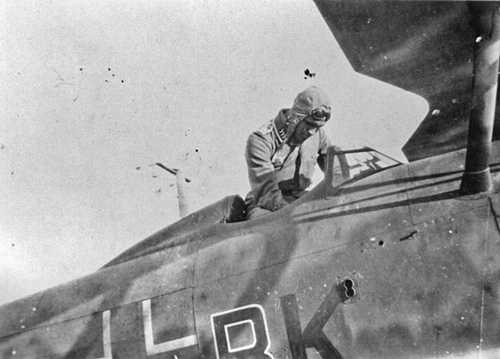
German Air Force
Over Anzio and Nettuno by night
dalnet.se
A Luftwaffe’s pilot mounting on board of a Fiat CR.42LW of 2./NSG 9 in Central Italy, Spring/Summer 1944. According a source the pilot is the Feldwebel Horst Greßler which, during the night of 1st June 1944, was injured when he crashed at Fabrica di Roma after having attacked Allied gun positions and columns in the Artena-Giulianello-Cori area Southeast of Rome. The Nachtschlachtgruppe 9 was the Luftwaffe’s unit equipped with the CR.42’s version built by Fiat for the Luftwaffe based in Italy for night harassment missions over the Allied lines included the Anzio landing head. The first nucleus of the NSGr.9 was formed on Autumn 1943 in Germany with ten experienced crew of NSGr.3 withdrawn from the northern sector of the Eastern Front during October 1943 to form the nucleus of NSGr.9. Early equipped with twin engines Caproni Ca.314 for anti-partisan missions the first Staffel of the NSGr.9 (1./NSGr.9) moved to Udine, Italy, in December 1943 to test the Ca.314’s combat-worthiness, initially in daylight. In January 1944 the Staffel was moved to Caselle airfield, Turin, for anti-guerrillas operations on SW Alps, but the Ca.314 reveled unsuitability for combat, particularly in improvised night operations. On 28 January a second Staffel was set up, with Fiat CR.42LWs, which replaced the Ca.314. In January 1944 the Allies noticed the unit for the first time as E8 Communications Unit not suspecting that it was a combat outfit. During February, seven aircraft of 1. and two from 2. Staffel was based at Rome, Centocelle airfield. The first operational sorties of the NSGr.9’s CR.42 date just after the landings at Anzio and Nettuno. Half-dozen of CR.42s was deployed at Viterbo during March for night harassment missions. The later were essentially confined to moonlight periods because the lack of navaids on board of the planes and the insufficient experience of the pilots and the profile of flight over mountainous terrain. Despite the strong AA defence of the Allied beachhead the losses were few. The Fiat biplane flew also some night missions against Allied forces on Monte Cassino area. A heavy loss was suffered when five American Thunderbolt strafed the Rieti airfield (80 km North of Rome) on 21 April 1944: five CR.42s destroyed on the ground. On 22 May the leader of the 2.NSgr 9 Staffel Kapitän, Oberleutnant Rolf Martini, was killed when his biplane crashed at Caselle, Turin, during a mock combat with Fiat's test pilot Valentino Cus. The NSgr 9’s CR.42LWs was gradually replaced by Junkers Ju.87D deployed on some airstrips of the Tuscany and Emilia Apennines. On 31 May 1944 2./NSGr.9 reported 18 CR.42s of which 15 were serviceable. On 8 June 1944 NSGr.9 brought three CR.42s and a pair of Ju87s to Bologna. During the 13-14 June 1944 night nine Stukas and CR.42s attacked with bombs and guns the Allied positions in the Viterbo-Montefiascone-Orbetello area on Central Italy. Victor Sierra
3460 Views
1/4/2009
